Rabbits have always been perceived as cuddly little animals suited for pets and exhibition purposes. But did you know they also can be raised for their delicious meat?
Breeders and homesteaders have been raising rabbits for meat due to their fast reproduction and sustainable breeding rate. Depending on how healthy and active the breeding rabbit is, it can provide around 125 pounds of meat per year.
The more does you have, the larger the number of kits that you can raise. In fact, they are much easier to raise compared to other meat animals like sheep or goats.
Without further ado, let’s dive right in and explore what it takes to successfully raise rabbits for their meat.
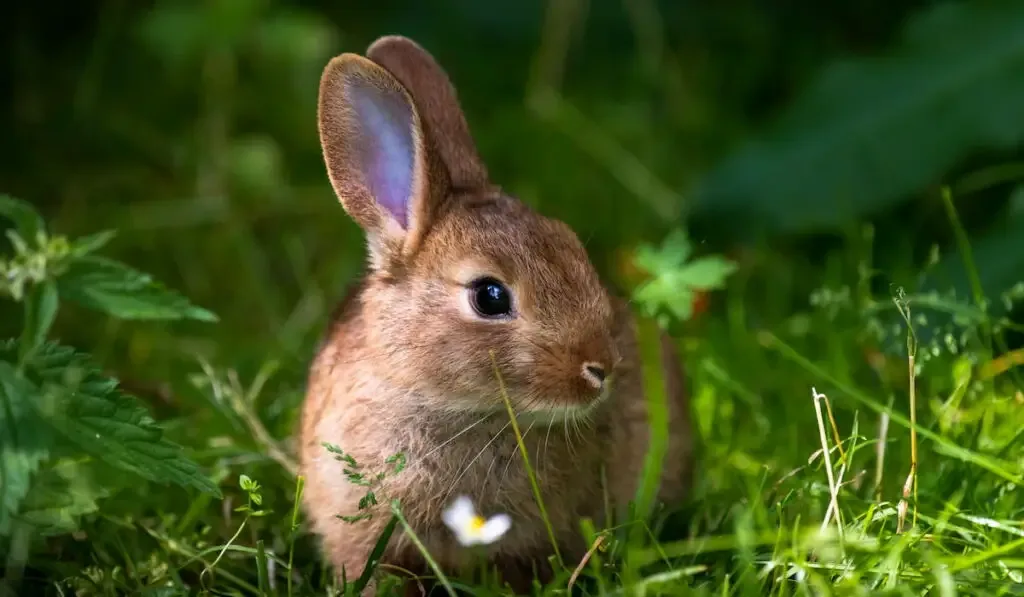
Choosing The Best Breed
According to data provided by the American Rabbit Breeders Association (ARBA), there are approximately 49 rabbit breeds found in the United States. But not all of them can be sustainably raised for their meats.
There are few things to consider when choosing a starting breed that can fulfill what you need. For instance:
- They are physically healthy without signs of illnesses or deformity. One of the easy ways to recognize healthy rabbits is that their eyes are clear, bright, and quick to react to any movement they see. They also can’t be young and underdeveloped.
- They don’t have overgrowth teeth. Rabbits with overgrowth teeth might suffer from jaw misalignment that contributes to the uneven growth of their teeth. They also could have internal health issues that are causing this problem.
- Their coats don’t molt or show any signs of molting fur. This can be recognized by touching their fur and finding that it isn’t soft or fluffy. Rabbits with molting fur are unhealthy due to the illnesses they might have or the dirty environments that they have been raised in.
- Avoid rabbits with wet noses that contain mucus, liquid discharge, or constant sniffles. These symptoms can indicate a rabbit with a contagious disease called Pasteurella.
Now that we have become clear on the do’s and don’t’s of choosing healthy meat rabbits, these are the best meat rabbit breeds that you can raise:
| Breed Name | Weight | Characteristics |
| Palomino | 8 to 12 pounds | Fast-grower |
| Florida White | 4 to 6 pounds | Good meat-to-bone and feed-to-meat ration |
| New Zealand White | 10 to 12 pounds | Excellent producer and the most common breed |
| American Chinchilla | 9 to 12 pounds | Prolific breeder |
| Beveren | 9 to 12 pounds | Fast-grower |
| Standard Rex | 7.5 to 10.5 pounds | Excellent fur producer |
| Cinnamon | 8 to 11 pounds | Good meat-to-bone ratio |
| Satin | 9 to 11 pounds | Great pelt and fur producer |
| Champagne D’Argent | 8 pounds | Great pelt producer |
| American | 9 to 12 pounds | Nurturing mother |
| Silver Fox | 9 to 12 pounds | Good meat-to-bone ratio |
| Californian | 10 to 12 pounds | Good meat-to-bone ratio |
| Flemish Giant | 15 to 20 pounds | Fast-grower and excellent meat-to-bone ratio |
| Altex | 13 pounds | Good pelt and fur producer |
Costs, Expenses, and Legalities
After deciding which breed you favor, then it is time to look at the expenses and how much you can expect to spend to successfully raise these animals. But before anything else, you have to check for regulations and laws in your locality.
Whether you want to raise rabbits for meat on your own property or a communal farm, there are few things to take note of regarding rabbit municipal ordinances. Depending on where you live, these ordinances might vary and they can include:
1. Permit
If you are raising a small herd of fewer than four rabbits, the authorities might waive the permit for you. But if you intend to raise a larger herd, then applying for a permit is a must.
On the other hand, if you plan to raise rabbits until they reach three months old and send them off to slaughter before they are fully mature, then you generally don’t need a permit for this type of operation. These types of rabbits are known as fryers or juvenile rabbits and they tend to produce much tastier meat.
2. Fees
The fee for your permit might vary depending on your location. For instance, rabbit breeders in Portland are charged a one-time fee of $31. This initial fee will gradually lower once you have made a renewal after a year or two.
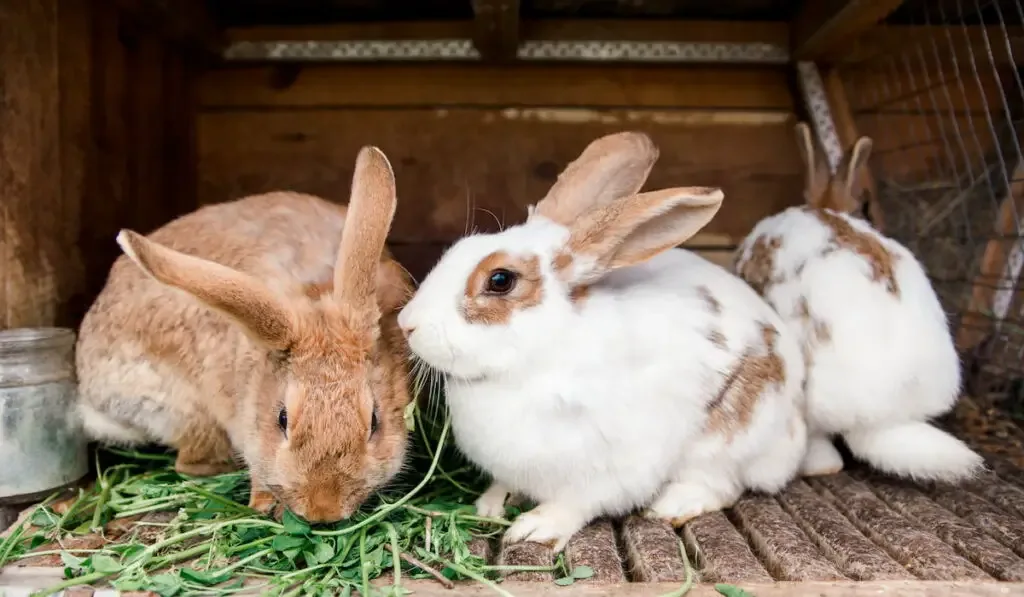
3. Herd Size
Without a proper permit, you are only allowed to raise a small herd, which is quite suitable for beginners and people who are doing this as a hobby. But once you get serious and apply for a permit, there are also a few herd specifications that you need to adhere to.
For instance, permitted rabbit herds should have at least a space of 10 to 15 square feet per animal. There is also a slaughter ordinance that allows only one animal per tenth of an acre to be slaughtered per week.
4. Neighborhood notice
Providing notice to your neighbors about your rabbit raising activity could vary depending on your location. For instance, if you’re living in Portland, you have to give out a notice to your neighbors within 150 feet of your property line.
5. Dwelling units
Living in big cities comes with limitations as homeowners aren’t allowed to keep too many animals or livestock in buildings like apartments or condominiums.
Meanwhile, some cities require people to have dwelling units or rabbit enclosures for extralegal urban farming. Depending on where you live, there might be a certain number of dwelling units that you can have at once.
6. Rabbit enclosure size, dimensions, and placement
Different regions will provide different guidelines for rabbit enclosures. It also depends on how wide your property is, and the number of rabbits that you want to raise.
In fact, you might have to submit a detailed plan for your rabbits’ hutch. Also, enclosures must be placed away from your neighbor’s property or property lines.
7. Sanitation and waste management
Like other animals, rabbits will produce tons of waste when they are being raised in a large herd. Aside from composting, you will have to follow any laws that prohibit actions that might pollute the water or even local environments.
Once you are well-informed on the laws and regulations, you can begin to search for your desired rabbit breed according to your budget. These animals aren’t expensive, especially younger ones which cost less than fully-grown rabbits.
For instance, New Zealand rabbits are priced as low as $10 per animal, while non-pedigreed Flemish giants could cost between $20 and $50 per animal. When starting out, all you need is a buck and two does, which cost around $75.

Building a Rabbit Shelter
Setting up the rabbit shelter is important to ensure that they live in a healthy and safe environment. This is the place where they spend most of their time to grow, reproduce, and take care of their babies.
Their shelter should also be strong and appropriate enough to protect the rabbits from harsh weather. Good ventilation should also be set up in and around the shelter to prevent overheating issues in the summer.
Some of the ways to build rabbit shelter are:
· Rabbit Hutches
Hutches should always be sheltered on three sides. They can also be built as closed enclosures using wooden materials. Each rabbit must be also be provided a space of at least nine square feet. Larger breeds might need a bigger space that can give enough room for them to stretch out.
Then, these hutches should also have another sub-floor containing litter boxes. This will ensure that they are living in a shelter with good hygiene.
· Colony Method
The colony method is more suitable when you are raising a large herd. Compared to hutches, raising rabbits in a colony will provide them enough space to run, play, and mingle with other rabbits.
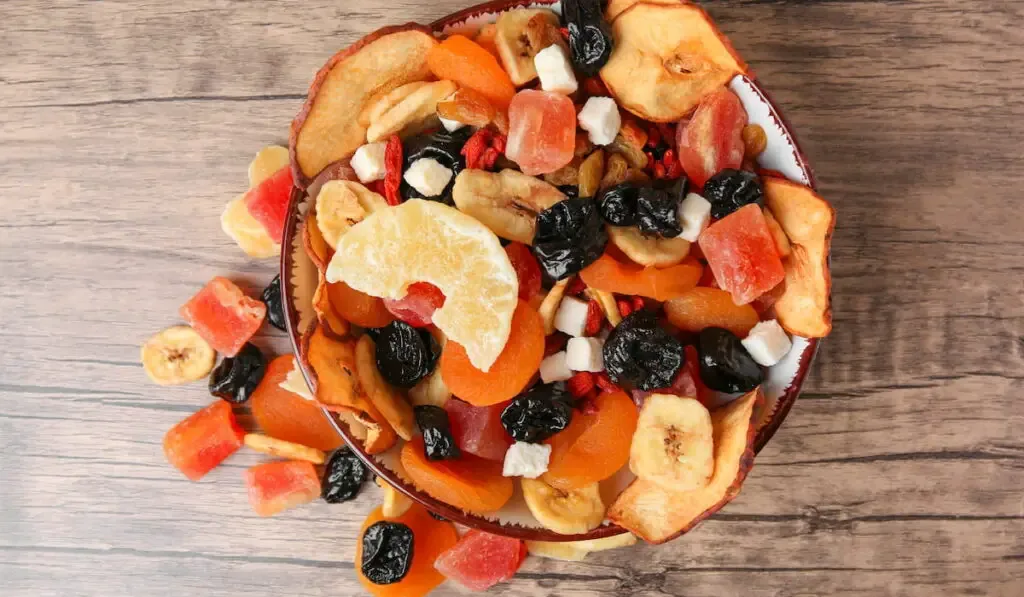
What To Feed Meat Rabbits
Good nutrition and a balanced diet are the two most crucial aspects to the development of healthy meat rabbits. Without fresh or healthy foods, their immune system can be compromised and they are prone to suffer from many diseases. Feeding rabbits is much cheaper and easier than any other meat animal.
A healthy diet for meat rabbits should contain a mix of several things. Here are some of the foods that your rabbits can eat:
· High-quality pellets
Pellets are the most common rabbit foods that you can find at any pet store. However, there are so many brands out there and you definitely have to pick the high-quality ones for better texture and nutrients composition. Avoid feeding your rabbits with pellets that contain corn.
Although corn itself is non-toxic, there is a certain mold that can be found in pellets containing corn that can be toxic to rabbits.
Also, be sure to find small pellets that can be digested easily by these animals. Generally, one rabbit should be fed half to one cup of pellets per day.
· Oats and barley
Fresh, unrolled barley and oats are definitely good for rabbits. Both of these foods are rich in fiber, proteins, nutrients, and a source of complex carbohydrates. They are not toxic to rabbits and easily digestible.
· Dried fruits
Some dried fruits such as oranges, papayas, mangoes, apples, bananas, pineapples, and melons can be fed to rabbits as treats, but only in small amounts.
However, these treats offer many benefits to your rabbits. For instance, papayas help in reducing the strong odor produced in rabbit’s urine.
Then, pineapples can help in reducing ‘fur block’ in rabbits, which is a condition where their digestive system is blocked due to their habit of eating their own fur.
· Grass hay
Grass hay is one of the best foods for rabbits. It is high in fiber and aids in facilitating good digestion and bowel movement. Avoid feeding rabbits with raw alfalfa hay because it is a legume, which is more suitable for cows, horses, and other livestock.
Although alfalfa can be a good source of protein, the high amount of calcium found in these plants can cause kidney stones in rabbits.
· Herbs and vegetables
Be it dried or fresh, herbs are one of the foods that provide supplemental vitamins, antioxidants, and nutrients to rabbits. Some of the fresh vegetables that rabbits love are carrot tops, radish leaves, beets leaves, sunflower leaves, spinach, and other green vegetables.
· Hay cubes
Aside from being a source of fiber, compressed hay cubes can be fed to rabbits because they assist in controlling teeth growth. Rabbit teeth don’t stop growing, even when they have matured. So, by chewing hay cubes, you can reduce overgrown teeth problems.
Furthermore, rabbits need different levels of nutrients in different stages of their lives. Here is the data from the National Research Council Publication 1194 about the nutrient requirements of rabbits:
| Categories of Production | Protein % | Fiber % | Fat (per lb.) | Calories % | Daily Intake (o.z) |
| Pregnant/Lactating (21-days old) | 16 – 20 | 12 – 14 | 3 – 5.5 | 1136 | No exact amount |
| Growing Fryer (1 to 3-months old) | 16 | 14 – 16 | 2 – 4 | 1136 | No exact amount |
| Replacement (3 to 5 months old) | 16 | 14 – 16 | 2 – 4 | 1136 | 6 – 8 |
| Breeding Bucks | 16 | 14 – 20 | 2 – 3 | 1136 | 6 – 8 |
| Dry Does/Bucks | 12 – 15 | 14 – 20 | 2 – 3.5 | 955 | 4 – 6 |
Last but not least, be sure to provide your rabbits with enough supply of water. You can use water bottles with ballpoint metal tubes to make it easier for them to lick on the dripping water. If you don’t mind spending more money, you can also install automatic waterers where you don’t have to schedule a daily or weekly refill.
Health Issues To Be Aware Of
Just like other animals, rabbits can also suffer from health issues if they are not being taken care of properly. But most of the time, these animals are sturdy, resistant to most diseases, and easy to handle.
Some of the few most common health issues that you can deal with are:
- Hygiene problems
Rabbits are active animals and their shelter is the only place they will spend most of their time. Dirty shelters will increase their chance of getting sick or worse, contracting any bacterial illnesses that are caused by poor hygiene.
This is why you should schedule a daily or weekly cleaning to scrape their waste off or clean and sanitize their hutches. Their water container should also be cleaned to remove any algae build-up that could contaminate the water.
- Mites
Ear mites are a common condition that can happen in rabbits when they live in a dirty environment. Aside from regular hutch cleaning, you can also use a small amount of olive oil and tea tree oil to combat this problem. But if home treatment doesn’t work, then it is time to call the vet.
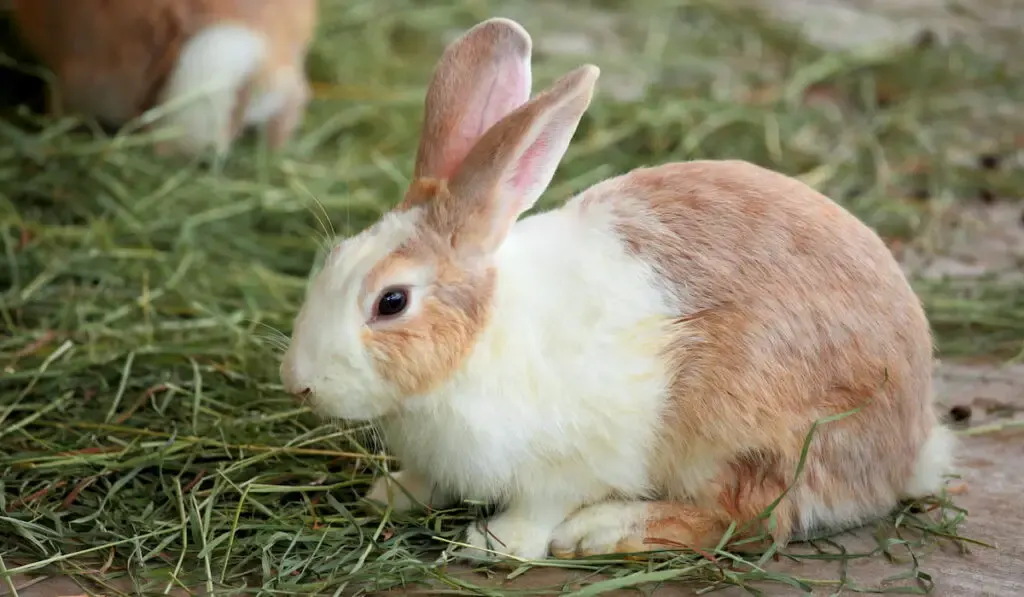
Breeding Process and Birth Cycle
As prolific and efficient breeders, does mature at seven months and they generally have a 30-day gestation period. Although mothers are ready to breed as soon as they give birth, it is advisable to give them a few weeks off before letting them produce other litters. This can help ease off any emotional tension that they have and keep these animals happy.
When the litters reach seven weeks old, they are called fryers. Fryers are considered grown enough to be without their mother and they will be weaned and placed in separated hutches before being butchered in another few weeks.
If you keep the rabbits until they reach three months old, you should separate the bucks from the does. At this stage, they can be butchered or keep as breeders.
Butchering Meat Rabbits
When the rabbits are mature enough to be butchered, there are a few things that you should know to avoid some common mistakes.
First and foremost, the rabbits should be stress-free to avoid the adrenaline rush that could worsen the flavor of the meat. Any feeding should be stopped between 24 and 48 hours earlier so that their digestive system is clear.
What you need are simple tools like sharp knives, a sharpener, flat plates or surfaces, gloves, and butchering items that you can buy in hardware stores. The butchering process should be as humane as possible.
Once they die, you can remove the skin, entrails, and clean the carcass before placing the meat in ice water for cleaning purposes. Then, you are free to cut the meat however you want.
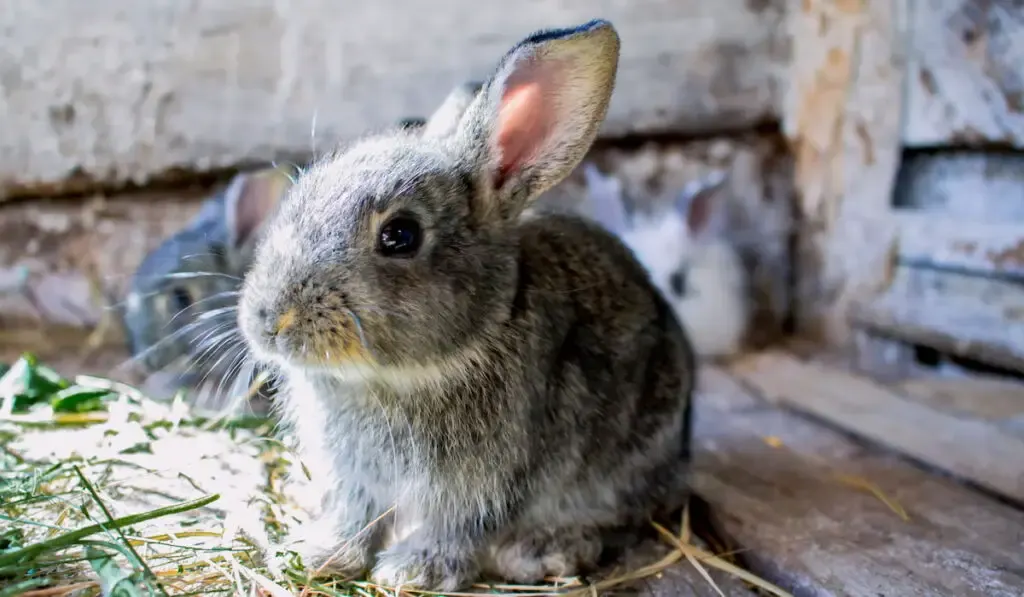
The Benefits Of Raising Meat Rabbits
As we already know, livestock like cows, goats, or sheep are favored by most people due to the obvious benefits that these animals provide. But don’t underestimate the good things that meat rabbits could offer.
There are many benefits of raising meat rabbits including:
- Meat rabbits are categorized as white meat animals. White meat is suitable and healthy for people who are looking to lose weight due to the low amount of fat found in this meat.
- Their meat is low in calories and free from cholesterol. People with high cholesterol and heart problems can safely eat meat rabbits without risking their health. The meat of rabbits also contains a low amount of sodium, which can be beneficial to people with high blood pressure.
- Other nutrients like phosphorus and calcium can also be found in the meat of rabbits. These compounds help in regulating body metabolism. Additionally, their meat is an excellent source of vitamins and minerals such as vitamin E, B3, and B12, potassium, and selenium.
- Compared to bigger animals like goats or cows, meat rabbits aren’t costly to raise. They aren’t noisy, don’t consume too much space, and are able to breed prolifically when raised in the right environment.
- Most meat rabbits produce less waste after being processed due to their higher meat-to-bone ratio. Unlike other livestock, breeds like New Zealand Whites or Californians have dense muscles, resulting in less offal (bones, organs, and hide).
Final Thoughts
Raising meat rabbits is definitely one of the great ways for people to achieve sustainable living in these modern days. With this comprehensive guide to raise these cute herbivores, anyone can definitely start this activity from anywhere. Being one of the more delicious meats can people can consume, there is a possibility that meat rabbit farms could be a booming industry in the future.
References:
- https://farmingmybackyard.com/basic-rabbit-care/
- https://www.homestead.org/livestock/raising-meat-rabbits-lessons-learned-back-to-front-raising-rabbits-for-meat/
- https://morningchores.com/raising-rabbits/
- https://www.moneycrashers.com/raising-rabbits-meat-farming/
- https://knowpreparesurvive.com/survival/prep/how-to-raise-rabbits-for-meat/
- https://rurallivingtoday.com/livestock/raising-rabbits-for-meat/
- https://www.anoffgridlife.com/how-to-raise-rabbits-for-meat/
- https://riseandshinerabbitry.com/2012/05/23/pellets-and-nutrition-for-meat-rabbits/

